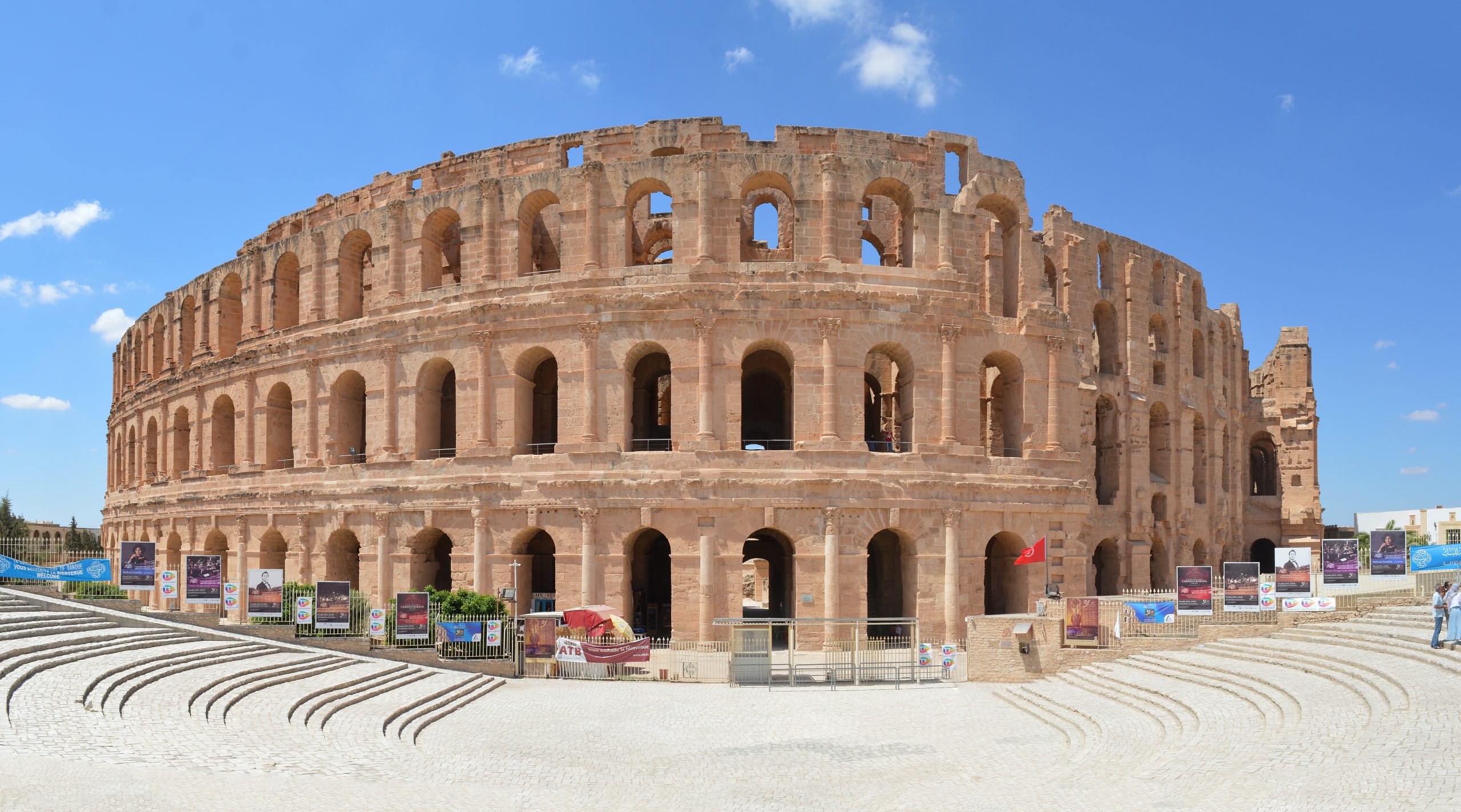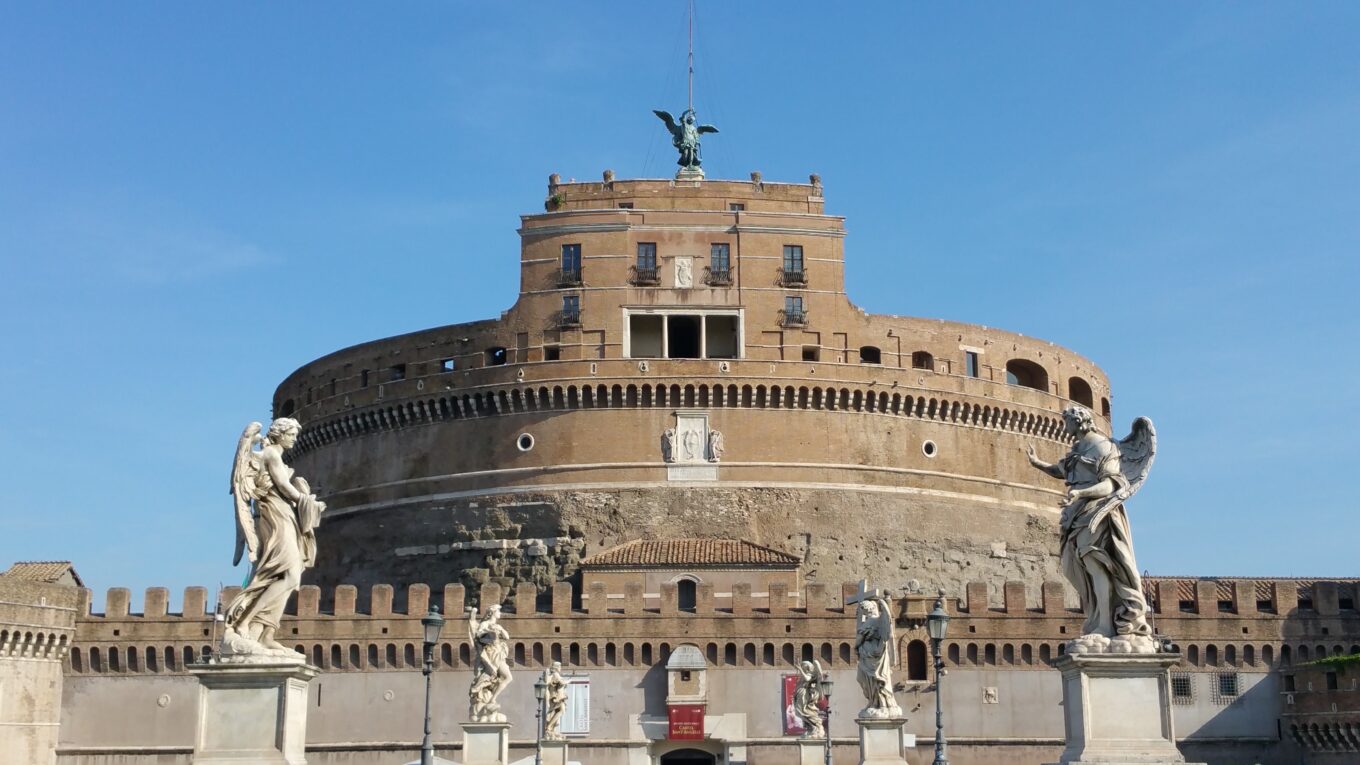Top 20 Roman Amphitheaters
Gladiatorial combat, executions, spectacles of man vs. beast – all things loved by the Roman People. What better place to view these crowd-pleasers, than within a Roman Amphitheater? Throughout the empire, Roman Amphitheaters were an important part of most major cities. The design is simple but revolutionary. So perfectly executed that it is still used to this day. The basic idea is to take two half-circle theaters, push them together, and create one semi-circular stadium. Even the ancient Latin word amphitheater translates to dual theater or double theater. This list will highlight 20 of the best-preserved Roman Amphitheaters that still survive from ancient times.
Who were the Romans and why did they build Amphitheaters?
At its peak, the Ancient Roman Empire spread from the British Isles in the northwest all the way to modern-day Egypt and Iraq in the southeast. Rome rose to power starting in 509 BCE and eventually fell in 476 CE. The Roman Emperors were constantly struggling to keep the peace amongst millions of Roman Citizens and they built amphitheaters as places for people to gather in mass and enjoy popular Roman spectacles. This really helped maintain order in the empire, and as long as they were entertained, the people were predominantly peaceful.
What are the best Roman Amphitheaters?
This list is a calculated effort to choose the top twenty Ancient Roman Amphitheaters that can still be visited today. We’ve collected plenty of data and based this list on three main criteria. First, the size of the amphitheater which is typically measured by seating capacity. Second, the preservation of the exterior façade; and finally, the preservation of the seating and viewing area. Together, these criteria determine the rankings of the Roman Amphitheaters below, starting with the greatest of them all and ending with amphitheaters that were unfortunately mostly dismantled over the ages.
1. Colosseum – Rome, Lazio, Italy

Capacity: 80,000+
The largest and most famous of all Roman Amphitheaters is, of course, the Colosseum. Able to hold an estimated 80,000 spectators, it is the largest arena by a huge margin. Construction began during the reign of Emperor Vespasian in 72 CE and was completed during the reign of Emperor Titus in 80 CE. Two notable earthquakes, among other events did significant damage to the structure, and much of the exterior façade and seats were repurposed in many of Rome’s other buildings. The majority of the façade was made of travertine with a marble veneer, and the rest of the structure was brick and concrete. In 2018 the Colosseum was the most visited site on earth, and it remains a symbol for the city of Rome and the Roman Empire.
2. Nîmes Amphitheater – Nîmes, Occitanie, France

Capacity: 24,000+
The Amphitheater of Nîmes was completed in 100 CE shortly after the completion of the Colosseum in Rome. Like other Roman Amphitheaters, the structure was used as a defensive fortress after the decline and fall of the Roman Empire. Today, most of the arena is still intact, including almost all of the seating and all 60 rows of the original exterior arches. In modern France, the amphitheater is used as a bullfighting arena during the summer months.
3. El Djem Amphitheater – El Djem, Mahdia, Tunisia
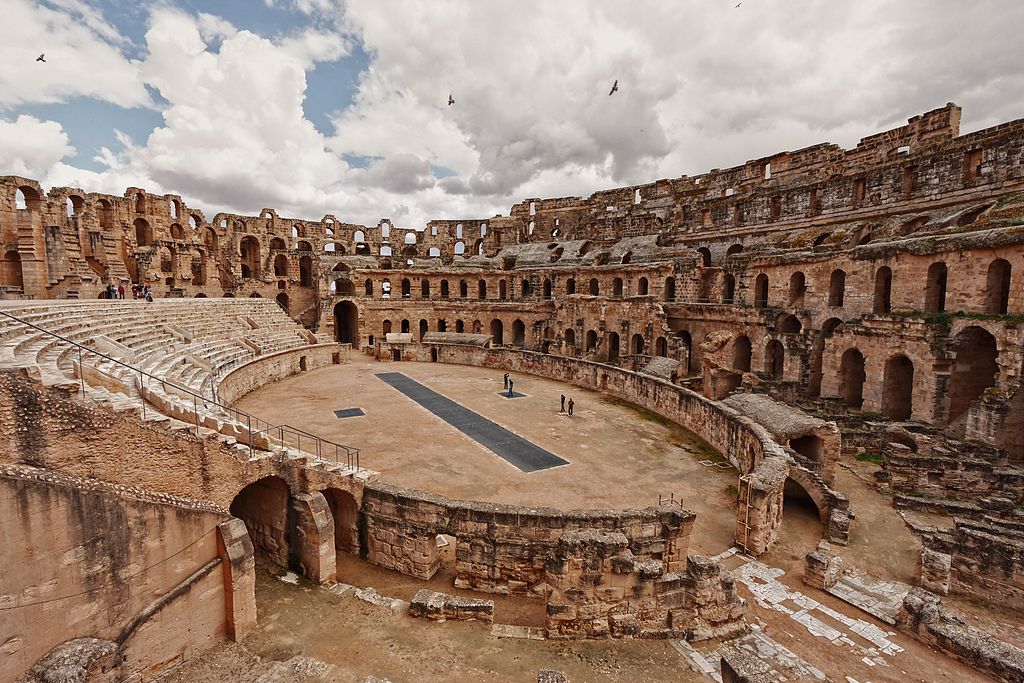
Capacity: 35,000+
El Djem’s Amphitheater is the tallest and most imposing structure in the entire city. It is the third-largest amphitheater on this list and is listed as a UNESCO World Heritage Site. Construction was completed in 238 CE and was built completely from the ground up, not sunken into the earth like many other arenas. All of the stone arches and seats are made out of yellow sandstone, which is commonly found in Tunisia. Although not as preserved as other Roman Amphitheaters, the sheer capacity and height of the exterior facade make it one of the most impressive remnants of Ancient Rome.
4. Arles Amphitheater – Arles, Provence, France
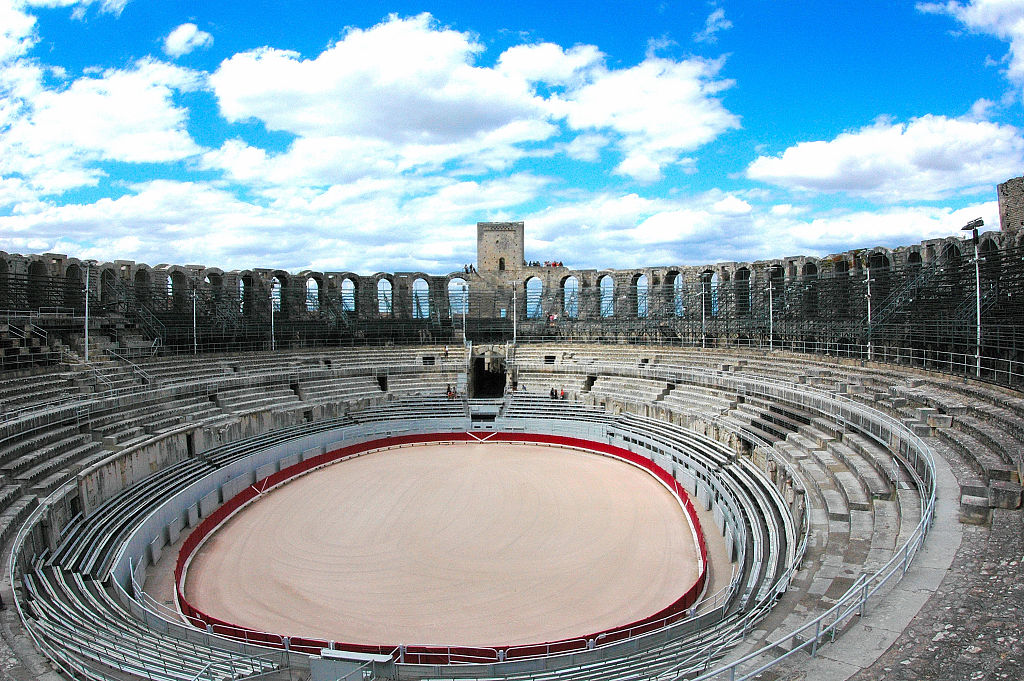
Capacity: 20,000+
Arles Amphitheater is not as large as many others on this list, but it is incredibly well-preserved. Most of the seats are still intact, along with the majority of the exterior façade. It is listed as a UNESCO World Heritage Site along with many other Roman buildings located in Arles. During the Middle Ages, the arena was repurposed as a defensive fortress. Many wooden structures were built within and on top of the stone structure. Three stone defense towers were also added, which can still be seen today.
5. Verona Amphitheater – Verona, Veneto, Italy
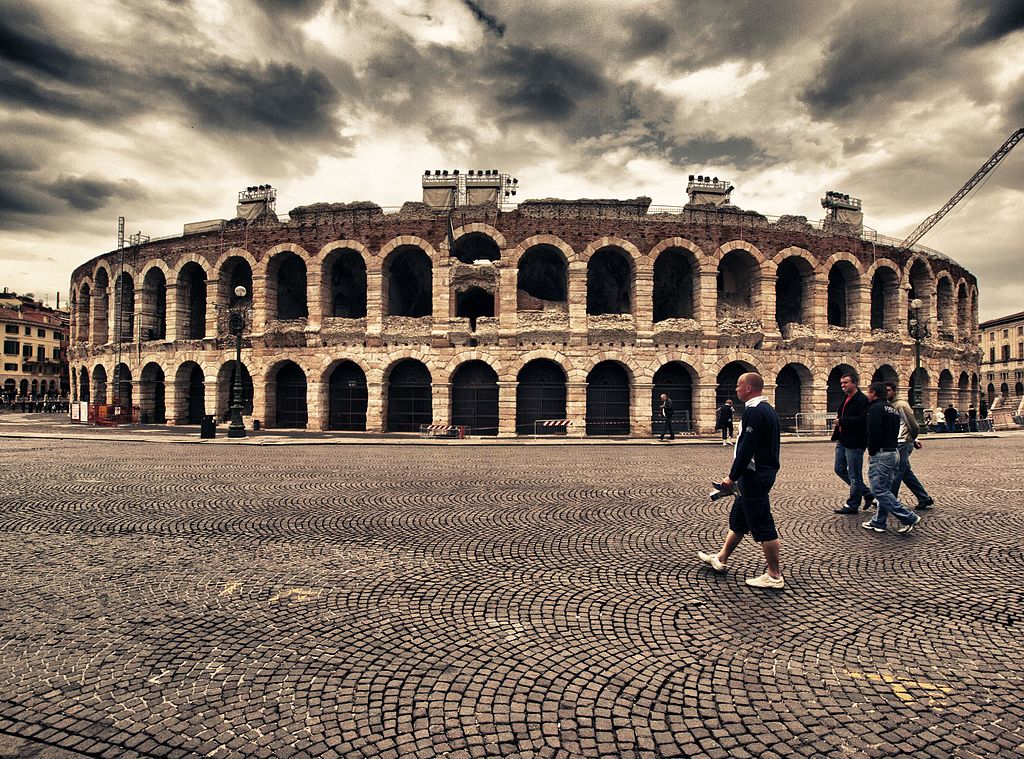
Capacity: 30,000+
Italy, being the oldest and most central of the empire’s many regions, contains a high concentration of Roman Amphitheaters. Located in Piazza Bra, the Verona Amphitheater is among the best preserved in all of Italy. Practically 100% of the seating and internal structure remains, but all but four of the original exterior façade arches were dismantled for other buildings. (an earthquake in the 12th century did significant damage to the outer façade, so the decision was made to reuse the material elsewhere) The arena was constructed around the year 30 CE. Today it is one of the most notable sites in Verona and it still is used for concerts and performances being viewed by over half a million spectators each year.
6. Pula Amphitheater – Pula, Istria, Croatia
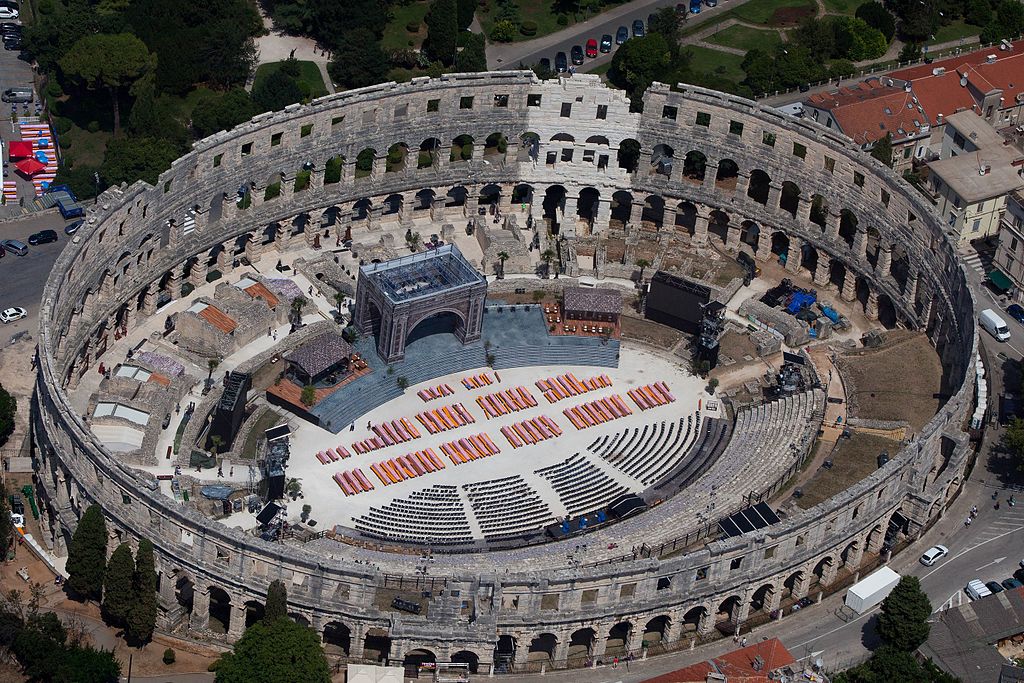
Capacity: 23,000+
Pula Amphitheater is one of the most notable Roman sites in all of Croatia. It has arguably one of the most spectacular and well-preserved exterior facades of any Roman Amphitheater. Although modified several times in its history, the structure that we see today was completed in 81 CE. The taller façade reaches a soaring height of over 100’ and contains three tiers of archways.
7. Pompeii Amphitheater – Pompeii, Campania, Italy

Capacity: 20,000+
Pompeii’s Amphitheater is the oldest Roman Amphitheater that still survives today. Along with the entire city, the arena was buried by the eruption of Mt. Vesuvius in 79 CE. Today visitors to the Pompeii archeological site are allowed to walk in and around the amphitheater. Despite the number of spectators it could hold, the exterior façade is actually only one level, unlike other arenas on this list. This is because a lot of the structure was dug deep into the earth.
8. Uthina Amphitheater – Mohammedia, Ben Arous Governorate, Tunisia

Capacity: 16,000+
North Africa was an important region within the empire, and today, many of North Africa’s Roman Amphitheaters are remarkably well preserved. Uthina Amphitheater’s seats are only about 60% intact, but several stone arches from the original façade still survive to this day. About half of the arena was built sunken into an adjacent hill. The rest was built out from the ground with a grand façade that must have been a marvel in ancient times. Luckily, because of its secluded nature away from other major cities, it’s likely that the arena will be excavated more and more in the future.
9. Leptis Magna Amphitheater – Khoms, Murqub, Libya
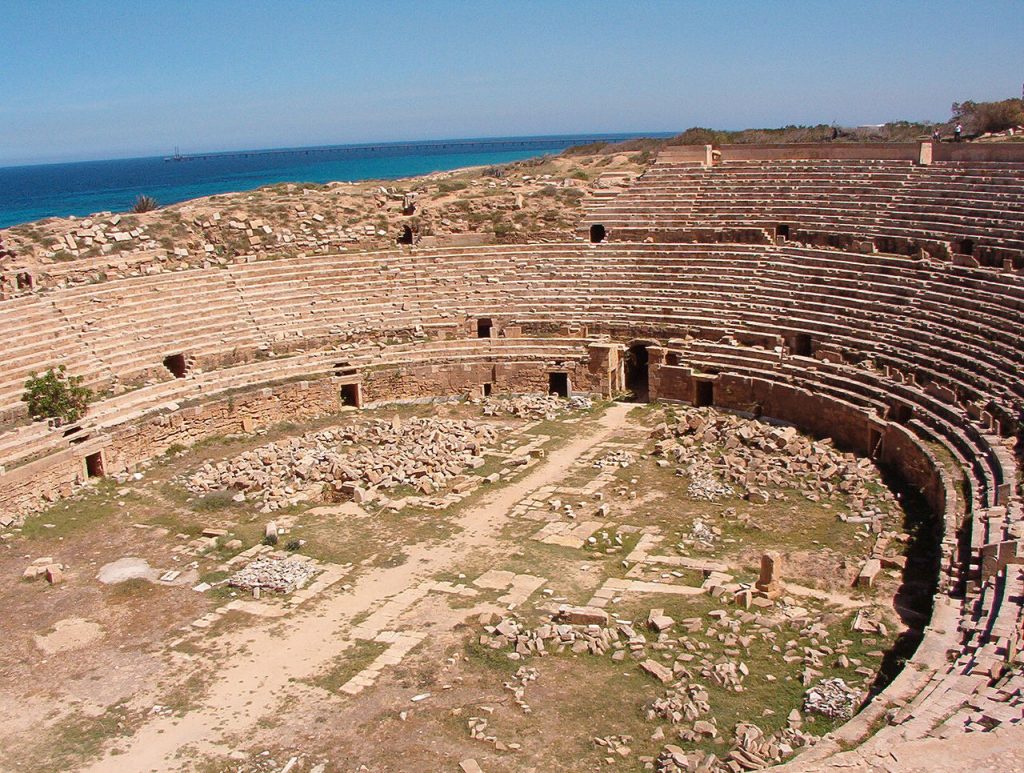
Capacity: 16,000+
A prominent North African city during the Roman Empire, Leptis Magna holds several notable Ancient Roman attractions, including a Triumphal Arch dedicated to Emperor Septimius Severus. The Amphitheater of Leptis Magna is a highlight of the entire area, its seating rows and aisles are very well preserved. Because the amphitheater was built into the Earth, within a natural depression, there is no surviving exterior façade. The construction was dedicated to Emperor Nero, which puts the completion date at around 56 CE.
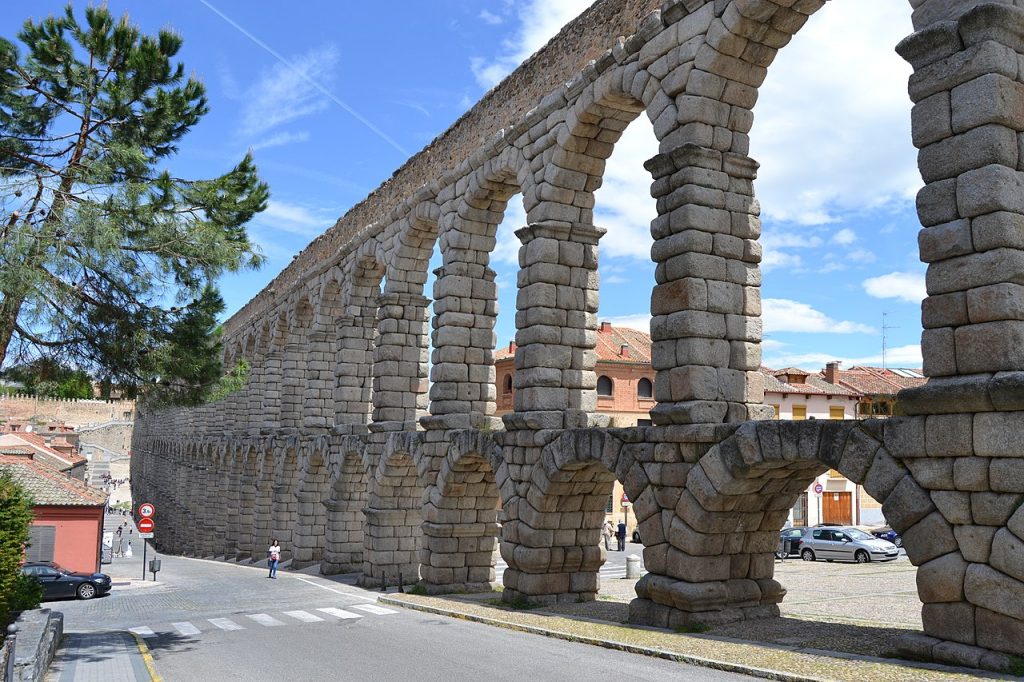
Like Ancient Rome? check out our article, “Top 20 Ancient Roman Aqueducts.”
10. Avenches Amphitheater – Avenches, Vaud, Switzerland

Capacity: 16,000+
Avenches Amphitheater was completed in the year 165 CE and is one of the top sites in Modern Avenches. Originally called Aventicum, the city was the capital of Roman Switzerland. Large portions of the exterior façade were removed for other buildings, and a lot of the rows of seating are still unexcavated. Visitors are allowed to enter the center of the arena and stand exactly where gladiatorial battles used to take place. This arena is the only Swiss amphitheater on this list, and one notable feature is the defensive tower that was added to the structure in the 11th century.
11. Tarragona Amphitheater – Tarragona, Catalonia, Spain
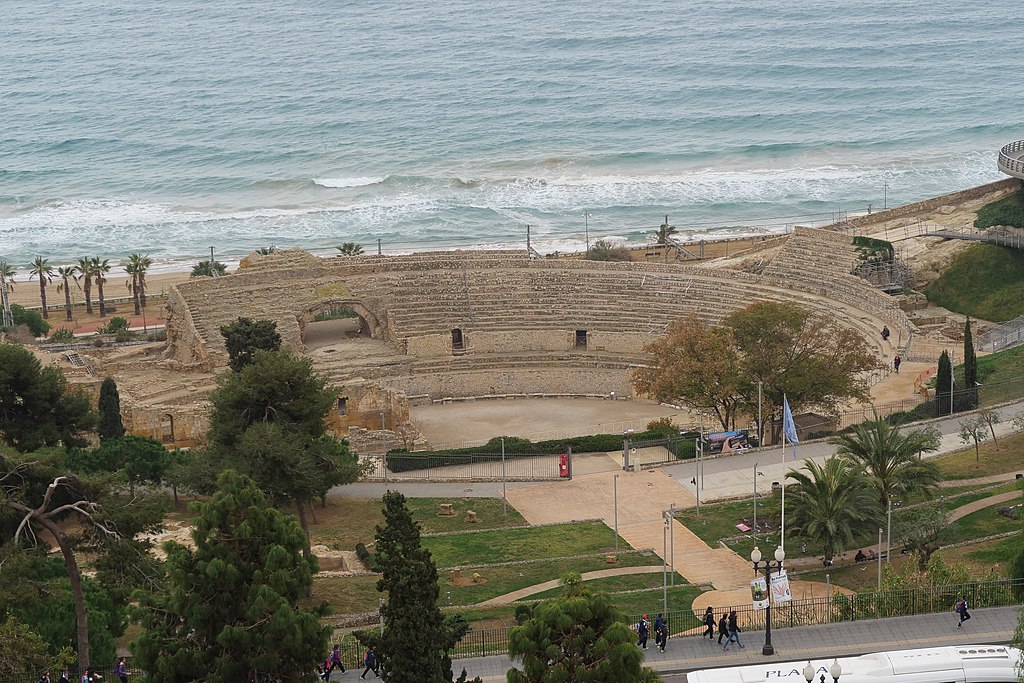
Capacity: 15,000+
The Ancient Roman Amphitheater in Tarragona is currently classified as a UNESCO World Heritage Site, along with other ancient structures in the city. The arena has an idyllic position, overlooking the Mediterranean Sea to the South. About 50% of the seating rows are still preserved, as well as a good portion of the archways on the south façade. Construction began in the 2nd century CE when the city was called Tarraco. Today, visitors to the amphitheater can walk around the rows of seats, and if you climb to the top, you are rewarded with a magnificent view of the ocean beyond.
Like Architecture of Cities? Sign up for our mailing list to get updates on our latest articles and other information related to Architectural History.
12. Mérida Amphitheater – Mérida, Extremadura, Spain
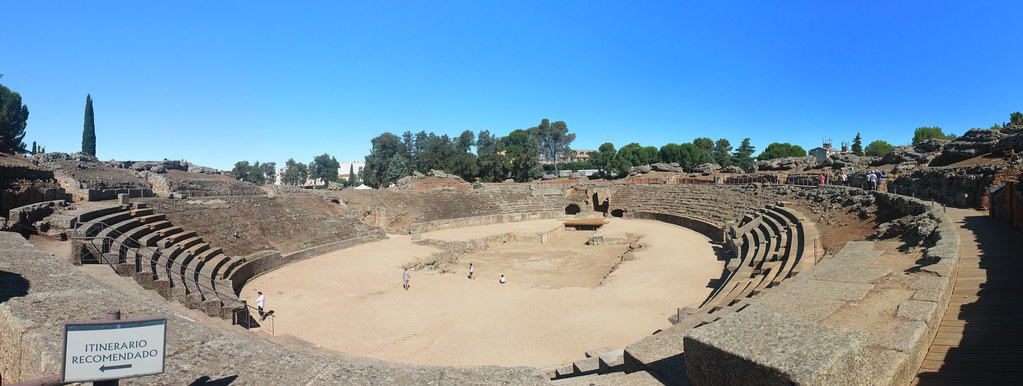
Capacity: 15,000+
Mérida’s Roman Amphitheater, as well as the Roman Theater, aqueduct, and Bridge, are some of the most notable Roman sites in all of Spain. Together, these structures are classified as UNESCO World Heritage Sites. The majority of the structure, including the top two seating sections, was repurposed in other buildings.
13. Italica Amphitheater – Santiponce, Andalusia, Spain

Capacity: 25,000+
Italica is a historic site, located about 5 miles north of the town of Santiponce in Spain. The amphitheater and other remnants of the Ancient Roman city are a popular day trip from nearby Seville. Italica was a large city in Roman times, founded in 206 BCE by the general now known as Scipio Africanus. The birthplace of at least two Roman Emperors, Hadrian, and Trajan, Italica was known to have large and notable buildings. The amphitheater was also recently used as a filming location for Game of Thrones in 2017, in a scene where a few main characters (and their dragons) meet.
14. Trier Amphitheater – Trier, Rhineland-Palatinate, Germany
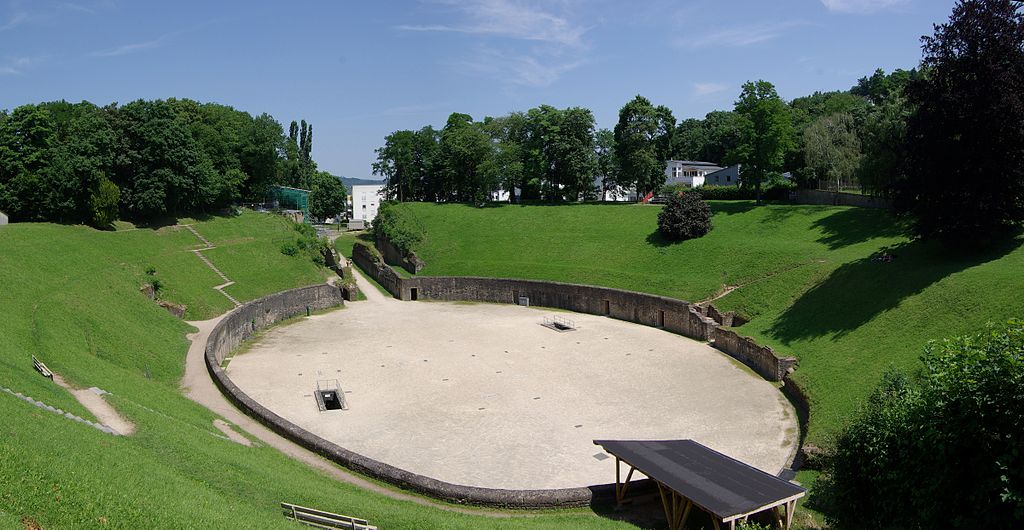
Capacity: 20,000+
Trier Amphitheater is the best-preserved Ancient Roman Amphitheater in all of Germany. At the time of its construction, Trier was a leading city in the Roman province of Gaul. Trier continued to grow in importance later becoming a regional capital in the later stages of the Western Roman Empire. Today the Roman monuments of Trier, along with several other historic buildings in the city, are recognized as UNESCO World Heritage Sites.
15. Alexandria Amphitheater – Alexandria, Egypt
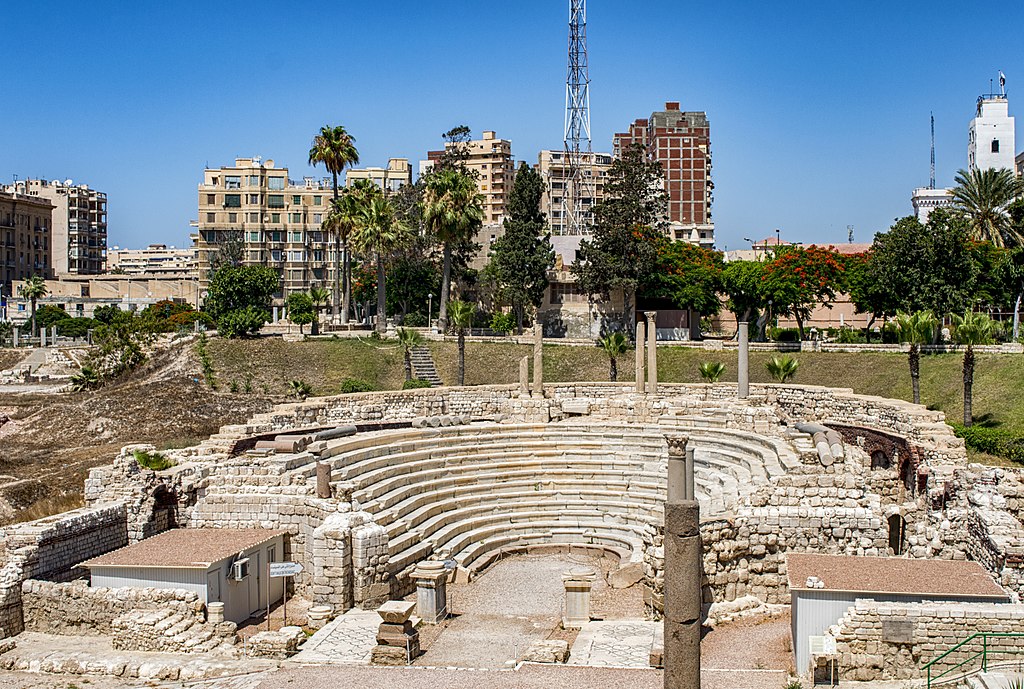
Capacity: 600+
By far the smallest on this list, Alexandria’s Amphitheater could only have held about 600+ spectators. Many historians believe it was used more for concerts and plays rather than gladiatorial combat. One noticeable difference is the actual marble seats that still exist today. Completed in the 4th century CE, this amphitheater was built during the Roman occupation of Egypt. It’s one of the top Roman sites located in the ancient city, which was founded by Alexander the Great.
16. Lecce Amphitheater – Lecce, Apulia, Italy
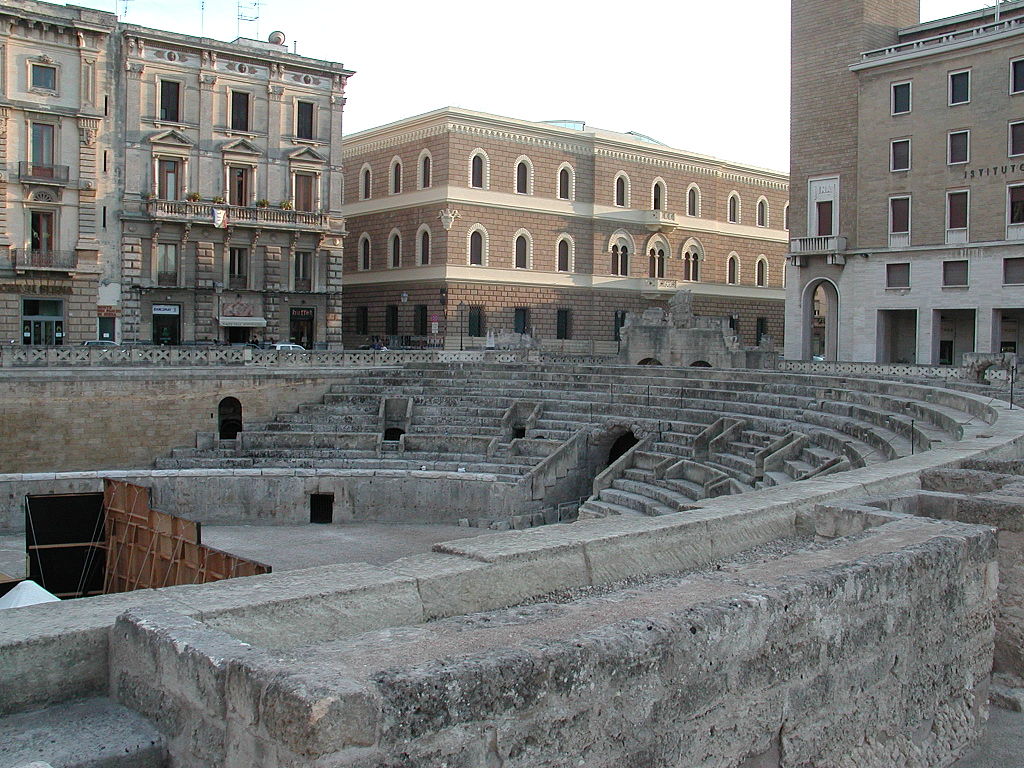
Capacity: 25,000+
The Amphitheater of Lecce is still largely unexcavated. It’s highly unlikely it will ever be excavated since the remainder of the structure is covered up by modern roads and buildings. During the time of the Romans, the city was named Lupiae and was a major city on the “heel” of the Italian Peninsula. The seats and façade of the arena are made of yellow-white sandstone, the same material that is used on many other significant buildings in the city.

Check out our article, “Top 15 Ancient Roman Triumphal Arches” to learn more about the architecture of the Roman Empire!
17. Cagliari Amphitheater – Cagliari, Sardinia, Italy
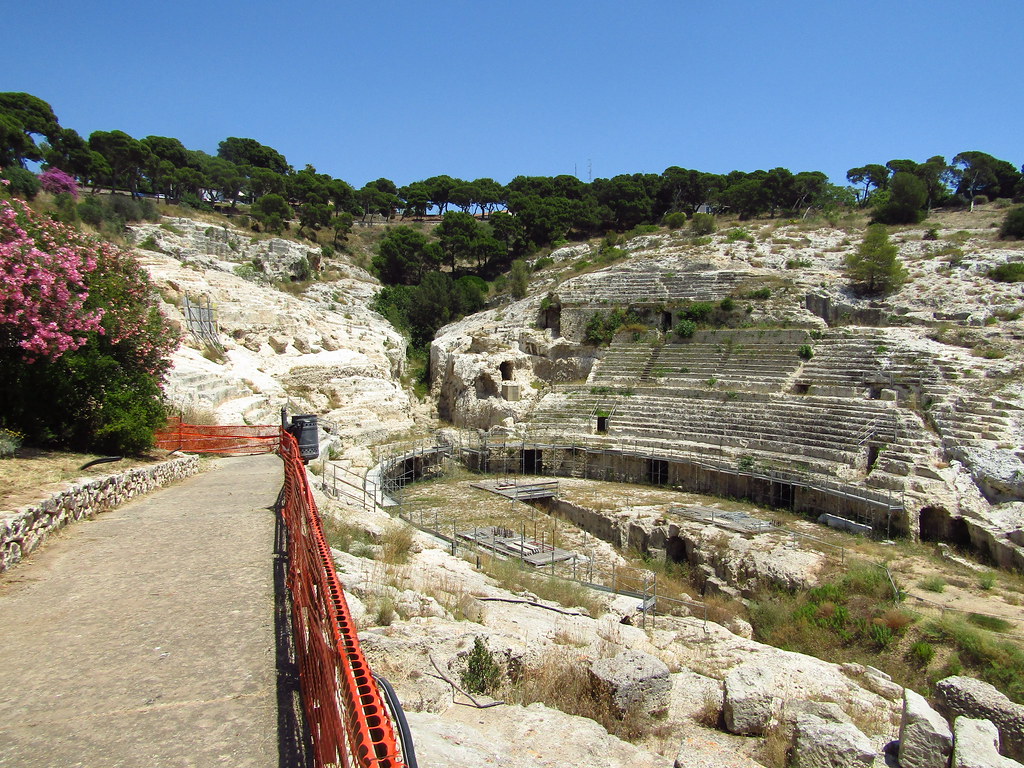
Capacity: 10,000+
The Roman Amphitheater of Cagliari differs from many of the others on this list since it was partially carved out of solid rock in the surrounding hillside. The hill of Buon Cammino is one of the tallest and steepest in Cagliari. Most of the seating was carved to match the slope of the hill, and there was also a large entry façade on the southern side. Today restoration work is still ongoing, so there’s a strong chance that more of the remains will be uncovered in the future.
18. Flavian Amphitheater of Pozzuoli – Pozzuoli, Campania, Italy
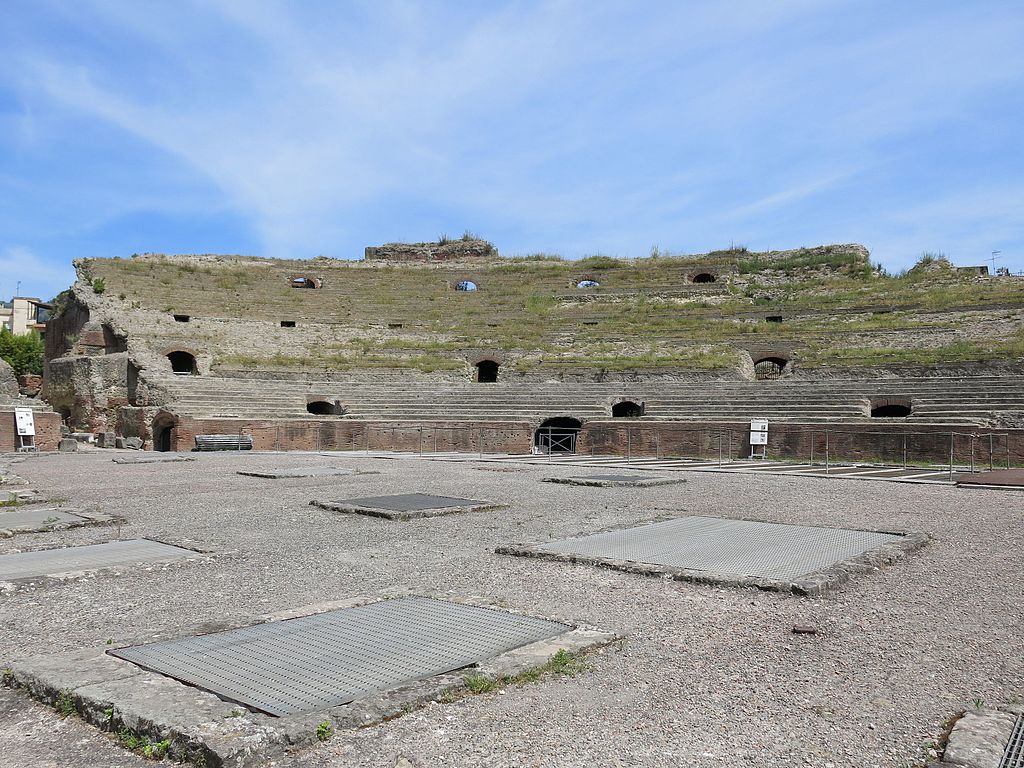
Capacity: 50,000+
The Flavian Amphitheater of Pozzuoli is the third-largest Amphitheater built during the Roman Empire. (“Flavian Amphitheater” is also a term widely associated with the Colosseum in Rome) Today several of the exterior arches and the vast majority of the seats remain, although all of the exterior marble veneers were reused in other buildings. The underground portion of this arena is among the best-preserved of all Roman Amphitheaters. Even some portions of the lifting mechanisms that connected the arena floor to the underground chambers are still intact.
19. Capua Amphitheater – Santa Maria Capua Vetere, Campania, Italy
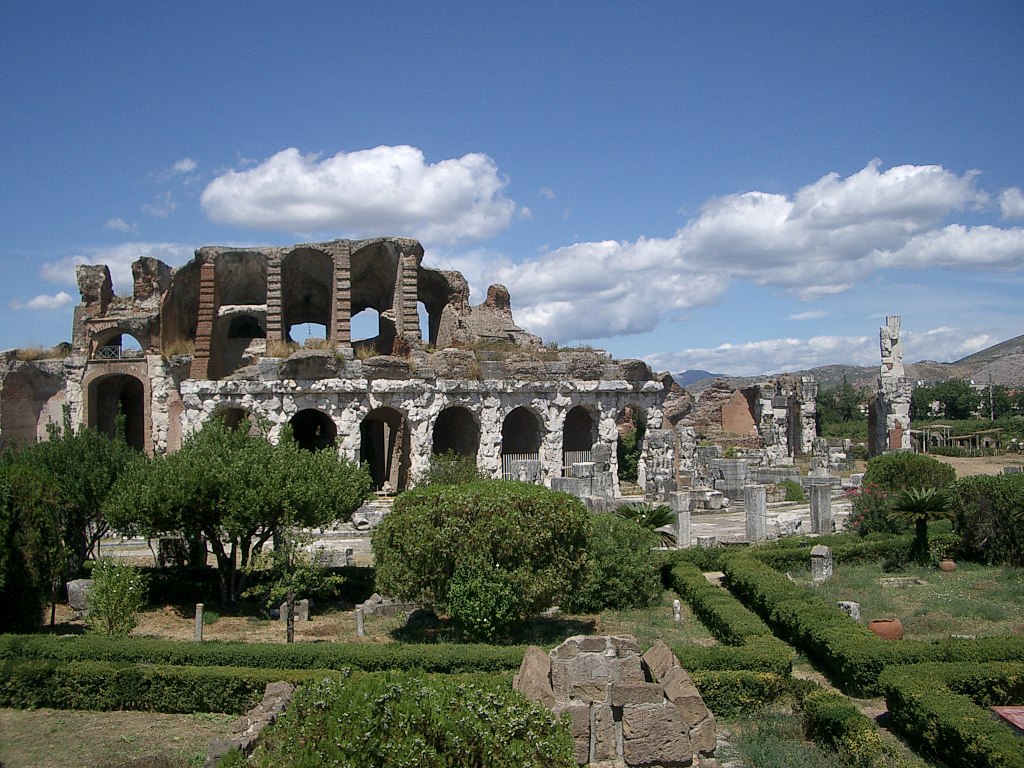
Capacity: 60,000+
The Amphitheater of Capua is the second-largest amphitheater that still survives from antiquity. It is believed to be the model for the Colosseum in Rome. Today, only a few of the original arches and about 30% of the original seating rows are still intact. The arena was the center point in a very well-known event in Roman history, the Revolt of Spartacus that started in 73 BCE.
20. Aquincum Amphitheater – Budapest, Central Hungary, Hungary

Capacity: unknown
The Ancient Roman City of Aquincum was located on the Danube River in what is now Budapest. The city actually contained two separate Roman Amphitheaters, the Aquincum Miltary Amphitheater (depicted above) and the Aquincum Civil Amphitheater. In addition to being used for organized spectacles, the Aquincum Military Amphitheater was an important military training facility. Today, the amphitheater lies at the southern edge of the Obuda district of Budapest.
Roman Amphitheaters Today
Today, Roman Amphitheaters have left a lasting legacy on architectural history. Many of the amphitheaters on this list are still used for events to this day. They remain symbols of the Roman Empire, and the fact that they can be found all over the Mediterranean is a testament to the reach and power of the Romans.
The model for the Roman Amphitheater has been reproduced all over the globe. One great example is the Harvard Colosseum in Cambridge, Massachusetts, United States. Used as a football stadium for Harvard University, the exterior facade resembles what most Roman Amphitheaters would have looked like in their prime.
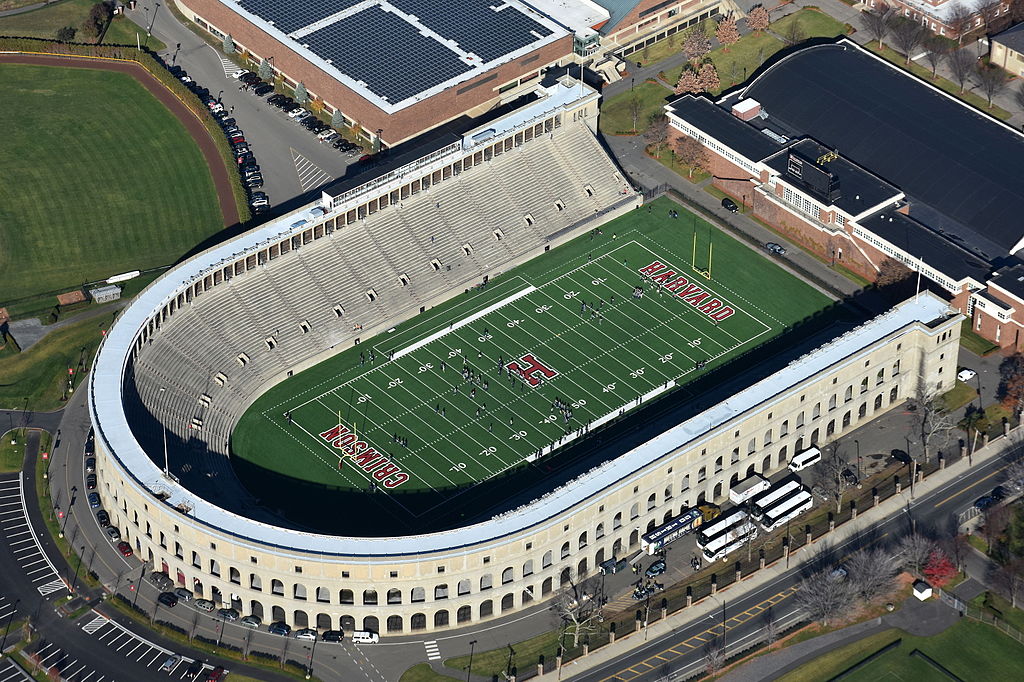
Photo by Nick Allen from Wikimedia Commons
Conclusion
The Roman Empire was one of the most influential civilizations to have ever existed. They created monumental structures and made incredibly significant advancements in construction and engineering. Their largest and most emblematic structures were their amphitheaters. Throughout the lands of the Roman Empire, some 400 arenas remain. This list shows 20 of the best-preserved examples, each one a significant site that is worth a visit. Two honorable mentions that did not make this list are the Roman Amphitheater of Lucca, Italy, which has since been repurposed as a public square, and Serdica Amphitheater in Sofia, Bulgaria, where today a modern hotel atrium is built surrounding the ancient structure.

- About the Author
- Rob Carney, the founder and lead writer for Architecture of Cities has been studying the history of architecture for over 15 years.
- He is an avid traveler and photographer, and he is passionate about buildings and building history.
- Rob has a B.S. and a Master’s degree in Architecture and has worked as an architect and engineer in the Boston area for 10 years.
Like Architecture of Cities? Sign up for our mailing list to get updates on our latest articles and other information related to Architectural History.
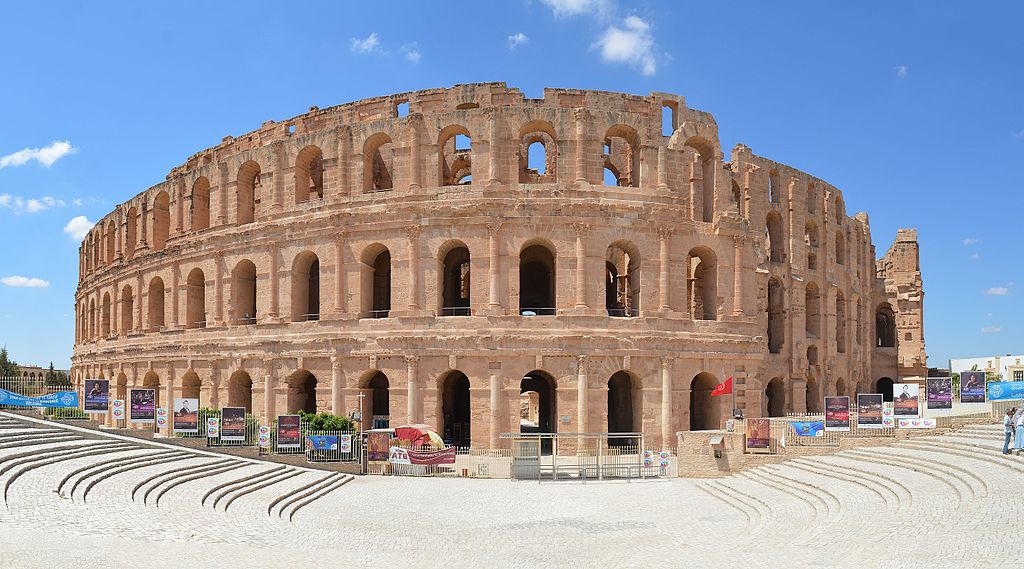
Photo by Mrabet.amir from Wikimedia Commons
